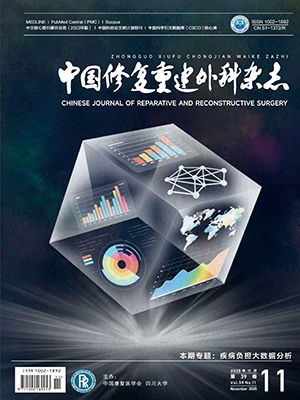| 1. |
Fusini F, Colò G, Risitano S, et al. Back to the future in traumatic fracture shapes of lumbar spine: An analysis of risk of kyphosis after conservative treatment. J Craniovertebr Junction Spine, 2021, 12(1): 38-43.
|
| 2. |
Liu FY, Gu ZF, Zhao ZQ, et al. Modified grade 4 osteotomy for the correction of post-traumatic thoracolumbar kyphosis: A retrospective study of 42 patients. Medicine (Baltimore), 2020, 99(37): e22204. doi: 10.1097/MD.0000000000022204.
|
| 3. |
Hu W, Wang B, Run H, et al. Pedicle subtraction osteotomy and disc resection with cage placement in post-traumatic thoracolumbar kyphosis, a retrospective study. J Orthop Surg Res, 2016, 11(1): 112. doi: 10.1186/s13018-016-0447-1.
|
| 4. |
Wessels L, Komm B, Bohner G, et al. Spinal alignment shift between supine and prone CT imaging occurs frequently and regardless of the anatomic region, risk factors, or pathology. Neurosurg Rev, 2022, 45(1): 855-863.
|
| 5. |
Oren JH, Tishelman JC, Day LM, et al. Measurement of spinopelvic angles on prone intraoperative long-cassette lateral radiographs predicts postoperative standing global alignment in adult spinal deformity surgery. Spine Deform, 2019, 7(2): 325-330.
|
| 6. |
Pasha S, Ilharreborde B, Baldwin K. Sagittal spinopelvic alignment after posterior spinal fusion in adolescent idiopathic scoliosis: A systematic review and meta-analysis. Spine (Phila Pa 1976), 2019, 44(1): 41-52.
|
| 7. |
Te Hennepe N, Spruit M, Pouw MH, et al. Supine traction versus prone bending radiographs for assessing the curve flexibility in spinal deformity. Global Spine J, 2022, 12(7): 1345-1351.
|
| 8. |
Greenhill DA, Poppino KF, Jo CH, et al. Intraoperative prone radiographs during scheuermann kyphosis correction closely estimate standing thoracic and lumbar parameters at 2 years. J Pediatr Orthop, 2020, 40(10): 581-586.
|
| 9. |
Fei H, Li WS, Sun ZR, et al. Effect of patient position on the lordosis and scoliosis of patients with degenerative lumbar scoliosis. Medicine (Baltimore), 2017, 96(32): e7648. doi: 10.1097/MD.0000000000007648.
|
| 10. |
Yasuda T, Hasegawa T, Yamato Y, et al. Effect of position on lumbar lordosis in patients with adult spinal deformity. J Neurosurg Spine, 2018, 29(5): 530-534.
|
| 11. |
Lee SK, Lee SH, Song KS, et al. Lumbar lordosis of spinal stenosis patients during intraoperative prone positioning. Clin Orthop Surg, 2016, 8(1): 65-70.
|
| 12. |
張旭, 于海洋, 梁成民, 等. 俯臥位脊柱全長加壓CT檢查在骨質疏松性脊柱骨折伴后凸畸形治療中的作用. 中國脊柱脊髓雜志, 2018, 28(6): 516-521.
|
| 13. |
Roghani T, Zavieh MK, Manshadi FD, et al. Age-related hyperkyphosis: update of its potential causes and clinical impacts-narrative review. Aging Clin Exp Res, 2017, 29(4): 567-577.
|
| 14. |
Driscoll CR, Aubin Cé, Canet F, et al. Impact of prone surgical positioning on the scoliotic spine. J Spinal Disord Tech, 2012, 25(3): 173-181.
|
| 15. |
周思宇, 孫卓然, 李危石, 等. 矢狀位平衡影像學評價之爭議與現狀. 中國修復重建外科雜志, 2018, 32(11): 1365-1370.
|
| 16. |
Duke K, Aubin CE, Dansereau J, et al. Computer simulation for the optimization of patient positioning in spinal deformity instrumentation surgery. Med Biol Eng Comput, 2008, 46(1): 33-41.
|
| 17. |
Salem W, Coomans Y, Brismée JM, et al. Sagittal thoracic and lumbar spine profiles in upright standing and lying prone positions among healthy subjects: Influence of various biometric features. Spine (Phila Pa 1976), 2015, 40(15): E900-E908.
|
| 18. |
Brink RC, Colo D, Schl?sser TPC, et al. Upright, prone, and supine spinal morphology and alignment in adolescent idiopathic scoliosis. Scoliosis Spinal Disord, 2017, 12: 6. doi: 10.1186/s13013-017-0111-5.
|
| 19. |
Keshavarzi F, Azadinia F, Talebian S, et al. Impairments in trunk muscles performance and proprioception in older adults with hyperkyphosis. J Man Manip Ther, 2022, 30(4): 249-257.
|
| 20. |
Miyazaki M, Ishihara T, Abe T, et al. Effect of intraoperative position in single-level transforaminal lumbar interbody fusion at the L4/5 level on segmental and overall lumbar lordosis in patients with lumbar degenerative disease. Medicine (Baltimore), 2019, 98(39): e17316. doi: 10.1097/MD.0000000000017316.
|
| 21. |
卜聿凡, 黃廣鑫, 趙暢等. 全髖關節置換術脊柱-骨盆-髖關節矢狀面關系. 中國矯形外科雜志, 2021, 29(19): 1769-1773.
|
| 22. |
Cirillo Totera JI, Fleiderman Valenzuela JG, Garrido Arancibia JA, et al. Sagittal balance: from theory to clinical practice. EFORT Open Rev, 2021, 6(12): 1193-1202.
|
| 23. |
Zhou S, Sun Z, Li W, et al. The standing and sitting sagittal spinopelvic alignment of Chinese young and elderly population: does age influence the differences between the two positions? Eur Spine J, 2020, 29(3): 405-412.
|
| 24. |
Olivares OB, Carrasco MV, Pinto GI, et al. Preoperative and postoperative sagittal alignment and compensatory mechanisms in patients with posttraumatic thoracolumbar deformities who undergo corrective surgeries. Int J Spine Surg, 2021, 15(3): 585-590.
|
| 25. |
Legaye J, Duval-Beaupère G, Hecquet J, et al. Pelvic incidence: a fundamental pelvic parameter for three-dimensional regulation of spinal sagittal curves. Eur Spine J, 1998, 7(2): 99-103.
|
| 26. |
Barrey C, Roussouly P, Le Huec JC, et al. Compensatory mechanisms contributing to keep the sagittal balance of the spine. Eur Spine J, 2013, 22 Suppl 6(Suppl 6): S834-S841.
|
| 27. |
Wiedenh?fer B, Matschke S, Pitzen T, et al. Biomechanical compensatory mechanisms of hips and spine: The essentials for spine and hip surgeons. Orthopade, 2020, 49(10): 870-876.
|
| 28. |
Diebo BG, Ferrero E, Lafage R, et al. Recruitment of compensatory mechanisms in sagittal spinal malalignment is age and regional deformity dependent: a full-standing axis analysis of key radiographical parameters. Spine (Phila Pa 1976), 2015, 40(9): 642-649.
|
| 29. |
Sharma A, Pourtaheri S, Savage J, et al. The utility of preoperative magnetic resonance imaging for determining the flexibility of sagittal imbalance. Neurosurgery, 2018, 83(3): 465-470.
|
| 30. |
陳熙棒, 王克, 王向陽, 等. 不同體位對脊柱骨盆矢狀序列影響的研究進展. 中華骨科雜志, 2017, 37(22): 1424-1431.
|




